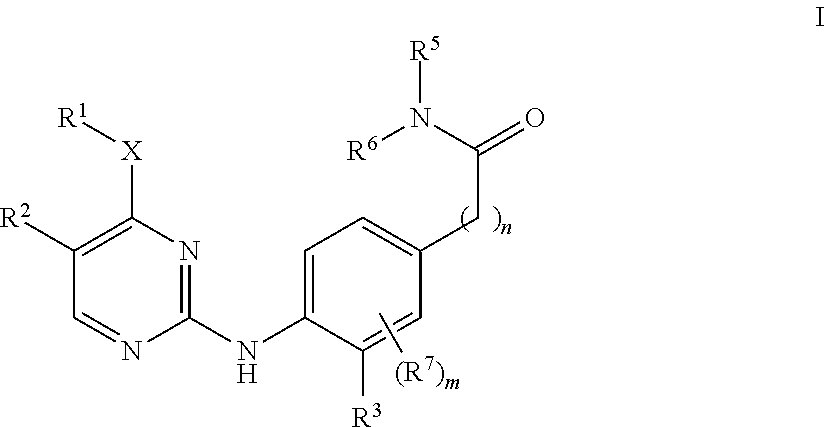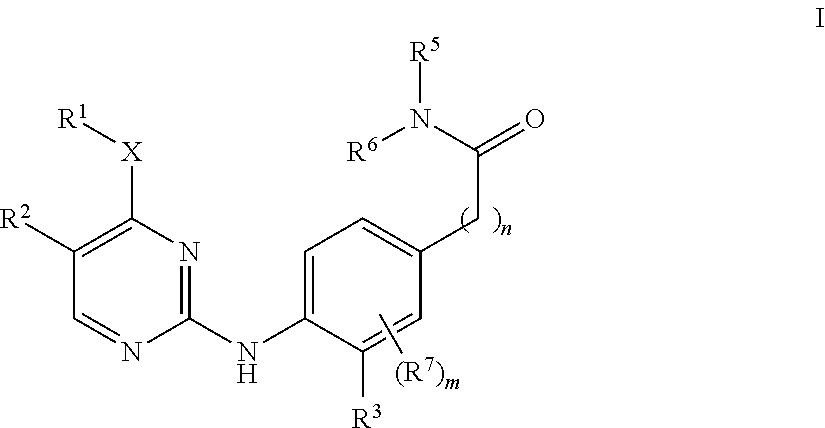Aminopyrimidine derivatives as lrrk2 inhibitors
- Summary
- Abstract
- Description
- Claims
- Application Information
AI Technical Summary
Problems solved by technology
Method used
Image
Examples
example 1
(4-(5-fluoro-4-(methylamino)pyrimidin-2-ylamino)-3-methoxyphenyl)(morpholino)methanone
[0540]
[0541]A mixture of 100 mg 4-(5-fluoro-4-(methylamino)pyrimidin-2-ylamino)-3-methoxybenzoic acid, 47 μL morpholine, 205 mg HATU, 188 mL diisopropylethylamine in 1 mL of dimethylformamide was stirred at room temperature overnight. The reaction was checked by LCMS and found to be complete. The reaction was diluted with EtOAc, and the organic layer washed with saturated NaHCO3 and brine. The organic layer was concentrated and purified by preparative reverse phase HPLC to yield 12 mg of (4-(5-fluoro-4-(methylamino)pyrimidin-2-ylamino)-3-methoxyphenyl)(morpholino)methanone.
[0542]Compounds made using the above procedure are shown in Table 4 below, together with proton NMR, and LRRK2 Ki (micromolar) data for selected compounds determined from the assay described below.
TABLE 4NameStructure1H NMRKI1[4-(5-Fluoro-4- methylamino- pyrimidin-2- ylamino)-3-methoxy- phenyl]-morpholin- 4-yl-methanone1H NMR(400...
example 2
[4-(5-Cyclopropyl-4-methylamino-pyrimidin-2-ylamino)-3-methoxy-phenyl]-morpholin-4-yl-methanone
[0543]
[0544]To a microwave tube was added (4-(5-bromo-4-(methylamino)pyrimidin-2-ylamino)-3-methoxyphenyl)(morpholino)methanone (56 mg, 0.13 mmol), potassium cyclopropyltrifluoroborate (39 mg, 0 27 mmol), cesium carbonate (0.13 g, 0.40 mmol), toluene (1.8 mL) and water (0.2 mL). The mixture was degassed by nitrogen bubbling for 15 mintues. XPhos (6.4 mg, 0 013 mmol) and palladium acetate (2 mg, 0.01 mmol) was then added. The reaction was heated in a Biotage microwave at 140° C. for 20 minutes. The reaction mixture was filtered and concentrated. The crude product was purified by RP-HPLC to give the desire product (12.6 mg, 25%).
[0545]Additional compounds made using the above procedure are shown in Table 4 above.
example 3
(4-(5-cyclobutyl-4-(methylamino)pyrimidin-2-ylamino)-3-methoxyphenyl)(morpholino)methanone
[0546]
[0547]To a microwave tube was added (4-(5-bromo-4-(methylamino)pyrimidin-2-ylamino)-3-methoxyphenyl)(morpholino)methanone (100 mg, 0.24 mmol), potassium cyclobutyltrifluoroborate (177 mg, 1.1 mmol), cesium carbonate (0.23 g, 0.71 mmol), toluene (2.9 mL) and water (0.3 mL). The mixture was degassed by nitrogen bubbling for 15 mintues. di-(1-admantyl)-n-butylphosphine (19 mg, 0.053 mmol) and palladium acetate (2.6 mg, 0.026 mmol) was then added. The reaction was sealed and heated at 11° C. for 2 hours. The reaction mixture was filtered and concentrated. The crude product was purified by RP-HPLC to give the desire product (8.1 mg, 8.6%).
[0548]Additional compounds made using the above procedure are shown in Table 4 above.
PUM
| Property | Measurement | Unit |
|---|---|---|
| Volume | aaaaa | aaaaa |
| Volume | aaaaa | aaaaa |
| Volume | aaaaa | aaaaa |
Abstract
Description
Claims
Application Information
 Login to View More
Login to View More - R&D
- Intellectual Property
- Life Sciences
- Materials
- Tech Scout
- Unparalleled Data Quality
- Higher Quality Content
- 60% Fewer Hallucinations
Browse by: Latest US Patents, China's latest patents, Technical Efficacy Thesaurus, Application Domain, Technology Topic, Popular Technical Reports.
© 2025 PatSnap. All rights reserved.Legal|Privacy policy|Modern Slavery Act Transparency Statement|Sitemap|About US| Contact US: help@patsnap.com



